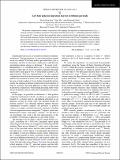Low hole polaron migration barrier in lithium peroxide
Author(s)
Ong, Shyue Ping; Mo, Yifei; Ceder, Gerbrand
DownloadOng-2012-Low hole polaron migration barrier in lithium peroxide.pdf (361.1Kb)
PUBLISHER_POLICY
Publisher Policy
Article is made available in accordance with the publisher's policy and may be subject to US copyright law. Please refer to the publisher's site for terms of use.
Terms of use
Metadata
Show full item recordAbstract
We present computational evidence of polaronic hole trapping and migration in lithium peroxide (Li[subscript 2]O[subscript 2]), a material of interest in lithium-air batteries. We find that the hole forms in the π* antibonding molecular orbitals of the peroxide (O2[superscript 2−]) anion, and that this trapped hole induces significant local lattice distortion, forming a polaron. Our study finds migration barriers for the free polaron to be between 68 and 152 meV, depending on the hopping direction. This low barrier suggests that this material might not be as insulating as previously assumed, provided that the formation of carriers can be achieved. One transport limitation may arise from lithium vacancies, which we find to strongly bind to the polaron. This result, in combination with previous experimental results, suggests that electronic conductivity in this material is likely to be determined by vacancy diffusion.
Date issued
2012-02Department
Massachusetts Institute of Technology. Department of Materials Science and EngineeringJournal
Physical Review B
Publisher
American Physical Society
Citation
Ong, Shyue, Yifei Mo, and Gerbrand Ceder. “Low Hole Polaron Migration Barrier in Lithium Peroxide.” Physical Review B 85.8 (2012). ©2012 American Physical Society
Version: Final published version
ISSN
1098-0121
1550-235X